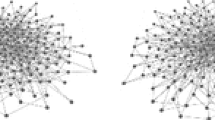Abstract
Simulation modelling has gained ground over the years since it can provide various scenarios applied to any scientific area. In this study, a stochastic cellular automata model is proposed, in which agents fall into three distinct categories (adopters, non-adopters and denials). Based on Hofstede’s cultural dimension individualism, we characterize three major international markets, as perfectly clustered (collective) to perfectly random (individualistic). We investigate innovation diffusion speed, in each network topology. At each time step, the decision of non-adopters to purchase innovative products, is affected by their immediate neighborhood (von Neumman). The speed of diffusion is evaluated using time at which sales reach 50% of market. Effects of simulation parameters on speed of diffusion, are assessed using a log-normal accelerated failure time model. Results demonstrate that diffusion of innovative products accelerates when innovators of a virtual economic system are placed according to a random network and when amount of innovators and imitators in the economic system increases. Slower innovative products’ diffusion process is a result of a large amount of denials and of how imitators are placed in the in the virtual economic system. Diffusion in small-world virtual economic systems lead to small time inflexion points very close to those of a random networked market.






Similar content being viewed by others
References
Akaike H (1974) A new look at the statistical model identification. IEEE Trans Autom Control 19(6):716–723
Ali AJ, Aziz TA, Krish K (1997) Individualism, collectivism, and decision styles of managers in Kuwait. J Soc Psychol 137(5):629–637
Barrat A, Weigt M (2000) On the properties of small-world network models. Eur Phys J B-Condens Matter Complex Syst 13(3):547–560
Bass FM (1967) A new product growth for model consumer durables. Manag Sci 15(5):215–227
Chandrasekaran D, Tellis GJ (2007) A critical review of marketing research on diffusion of new products. Rev Mark Res 39–80
Chandrasekaran D, Tellis Gerard J (2008) Global takeoff of new products: culture, wealth, or vanishing differences? Mark Sci 27(5):844–860
Deffuant G, Huet S, Amblard F (2005) An individual-based model of innovation diffusion mixing social value and individual benefit. Am J Sociol 110(4):1041–1069
Erdős P, Rényi A (1960) On the evolution of random graphs. Publ Math Inst Hung Acad Sci 5(1):17–60
Goldenberg J, Efroni S (2001) Using cellular automata modeling of the emergence of innovations. Technol Forecast Soc Change 68(3):293–308
Goldenberg J, Libai B, Moldovan S, Muller E (2007) The npv of bad news. Int J Res Mark 24(3):186–200
Goldenberg J, Libai B, Solomon S, Jan N, Stauffer D (2000) Marketing percolation. Phys A Stat Mech Appl 284(1–4):335–347
Golder PN, Tellis GJ (1997) Will it ever fly? Modeling the takeoff of really new consumer durables. Mark Sci 16(3):256–270
Hofstede G (2003) What is culture? A reply to Baskerville. Acc Organ Soc 28(7-8):811–813
Hofstede G (2009) Geert hofstede cultural dimensions
Kiesling E, Günther M, Stummer C, Wakolbinger LM (2012) Agent-based simulation of innovation diffusion: a review. Cent Eur J Oper Res 20(2):183–230
Kleinbaum DG, Klein M (2010) Survival analysis, vol 3. Springer, Berlin
Kleinbaum DG, Klein M (2011) Survival analysis: a self-learning text, 2005. Spring, New York
Moldovan S, Goldenberg J (2004) Cellular automata modeling of resistance to innovations: effects and solutions. Technol Forecast Soc Change 71(5):425–442
Petridis NE (2015) Convergence of random to power-law networks using a multi-objective non-linear programming model. J Multi-Criteria Decis Anal 22(5–6):232–243
Richins ML (1983) Negative word-of-mouth by dissatisfied consumers: a pilot study. J Mark 47(1):68–78
Rogers EM (2010) Diffusion of innovations. Simon and Schuster, New York
Sayama H (2015) Introduction to the modeling and analysis of complex systems. Open SUNY Textbooks, New York
Schwarz G et al (1978) Estimating the dimension of a model. Ann Stat 6(2):461–464
Thiriot S, Kant J-D (2008) Using associative networks to represent adopters’beliefs in a multiagent model of innovation diffusion. Adv Complex Syst 11(02):261–272
Toffoli T, Margolus N (1987) Cellular automata machines: a new environment for modeling. MIT Press, Cambridge
Von Neumann J (1951) The general and logical theory of automata. 1951:1–41
Watts DJ, Strogatz SH (1998) Collective dynamics of ‘small-world’ networks. Nature 393(6684):440
Wolfram S, Mallinckrodt AJ (1995) Cellular automata and complexity. Comput Phys 9(1):55–55
Zenobia B, Weber C, Daim T (2009) Artificial markets: a review and assessment of a new venue for innovation research. Technovation 29(5):338–350
Zhang D (2005) Modeling survival data with parametric regression models. Anal Surviv Data, 2005
Author information
Authors and Affiliations
Corresponding author
Additional information
Publisher's Note
Springer Nature remains neutral with regard to jurisdictional claims in published maps and institutional affiliations.
Rights and permissions
About this article
Cite this article
Petridis, K., Petridis, N.E. Diffusion of Innovations in Middle Eastern versus Western Markets: A Mathematical Computation Cellular Automata Simulation Model. Oper Res Int J 22, 1597–1616 (2022). https://doi.org/10.1007/s12351-020-00598-y
Received:
Revised:
Accepted:
Published:
Issue Date:
DOI: https://doi.org/10.1007/s12351-020-00598-y




